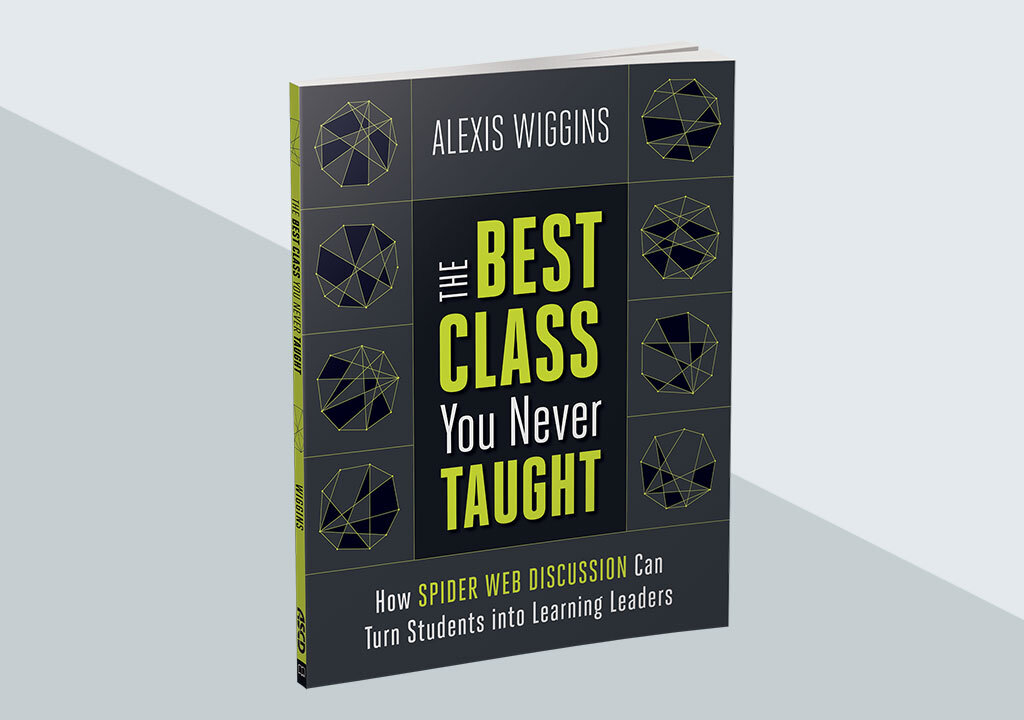Socratic seminar, Harkness, Spider Web Discussion—whatever you call it, we have always been big fans of student-led inquiry. Student-led discussion has the power to transform learning, whether it manifests as small-group conversations about narrative nonfiction books in a 3rd grade classroom; or in an 8th grade math class where students earnestly explore and debate what math is and what problems it can help us solve. But it isn't always clear how best to support this form of student-led inquiry. As instructional coaches, we have observed and learned from elementary, middle, and high school teachers leading student-led discussions. We are also classroom teachers ourselves: Tracy is a middle school English and social studies teacher, and Alexis is a high school English teacher. Thanks to that experience, we know that with the right strategies, educators can support student-led discussions that foster deep critical thinking and empathy. Here are a few tips we've developed that can help them do just that.
Tip #1: Stop talking so much and make time for inquiry.
Alexis: When I was an instructional coach, I worked with a high school English teacher who was hoping to introduce more inquiry into his classes and wanted specific feedback on how much he spoke during class. He was tired of "hearing his own voice" and wanted to design more activities that were hands-on and student-led. I visited his class and took some notes to track his talk time.
When we debriefed a few days later, the teacher confessed that he was shocked to see his total talk time. He had spoken for more than half of the observed lesson on a day in which his goal was to speak as little as possible.
The lesson we both learned is that we teachers are often not aware just how much or how long we talk. It's hard to let go of control and turn things over to students for collaborative inquiry. But in my work as a coach and consultant, I've always asked teachers to just try letting go and allowing students to lead the discussion. I've found sometimes the best way for a hesitant teacher to get comfortable with students leading the talk is just to give it one try; after that, it becomes easier. 100 percent of the teachers that follow up with me say they are astounded by what their students can do on their own. And students really get so much more out of it when they are leading the inquiry themselves.
In my work as a coach and consultant, I’ve always asked teachers to just try letting go and allowing students to lead the discussion.
Tip #2: Graph the discussion.
Tracy: My classroom discussions are based on Alexis's Spider Web Discussion model. By "graphing" classroom conversations and using this type of visual, students can reflect on their engagement and contributions during the discussion. These "webs" help us answer questions such as: Did we have a balanced conversation? Did all of us have equal opportunities to speak?
So how do we draw the web to track the conversation? We simply draw a circle or box and write the students' names around it to indicate where they are seated. As students talk, we draw a line from one speaker to the next; when another student speaks, we draw a line to that student, and so on. Hopefully, by the end, we have created a "web" that shows equity and balance.
I like to share these graphs by posting them in my room for students to observe. Recently, we finished our third discussion for Lord of the Flies, so we were able to step back and view all three discussions. Often, students will look at the webs and comment, "Wow, we all really talked during that discussion," or "There is one part of the group that dominated a bit," or "Look at how many more people spoke this time," and so on. Making these conversations visual has helped students grow in our discussion process by gaining confidence and becoming more aware of individual and group talk time.
We usually draw the graphs, but Alexis and I have also used a helpful app, Equity Maps. The app is a great way to focus on equity as one dynamic of classroom discussion because it breaks down participation by volume, duration, and gender. Tip #3: Use a rubric.
Alexis: Early in my career, I started teaching at the Masters School in Dobbs Ferry, New York – a "Harkness School," where roundtable discussion is the norm for every age group and in every discipline. I had previously encouraged discussion in my classroom, but I didn't have a method for giving helpful feedback to the students after discussion. Luckily, the English department at the school offered me a rubric to help me take student-led discussions deeper.
Tracy and I suggest creating a clear checklist-style rubric to help you track what you value and want to see in discussions. For my high school English students, some key points on the rubric are:
Students back up what they say with examples, quotations, etc. They refer to the text often.
Students take risks and dig for deep meaning and new insights.
Comments are not lost, the loud or verbose do not dominate, and the shy or quiet are encouraged.
You don't have to grade discussions, and if you do grade them, those grades don't have to "count." We find discussions are just as good when they are formative, as long as there is a rubric with clear criteria and feedback mechanisms built in.
Here are some rubrics we have used in the past:
Whether you use or adapt one of these rubrics above or make your own, the key is to make a simple, checklist-style rubric of the specific skills and behaviors you want the students to aim for in every discussion. The list of skills and behaviors should be written in a way that both you and the students can easily assess (e.g., "we did this" or "we didn't yet fully do this"), leading to an effective debrief or conversation after the assessment on what the group can do better in the next discussion.
Tip #4: Introduce peer coaching.
Tracy: About five years ago, a colleague observed one of my class discussions and suggested I try incorporating coaching into student partnerships to help deepen learners' inquiry skills. Most of our discussions were "fishbowl style," with one group forming an inner circle and another on the outside. I had always struggled with establishing the role of those on the outside. Do they listen and take notes? How do they then report back to those in the middle? How do they support and challenge their classmates? The coaching model was an all-in-one solution.
At the start of each unit/novel in our English class, students are assigned a "coaching partner" who they work with throughout the unit. (With an odd number of students, we create a "coaching trio.") Students are taught how to track the discussion as coaching techniques through modeling and roleplaying exercises.
I often ask students to pair up with their coaching partner for other activities in class to help build that relationship throughout the unit. These partnerships can carry on as reading or writing partners (providing one another feedback) or can just be a simple way to partner students up for everyday classroom activities.
In this specific type of fishbowl discussion, the coaches are on the outside, tracking the entire conversation—the web of all the students' contributions. Originally, they just tracked the contributions in pencil, but one student suggested that they use a different color to track their coaching partner's specific contributions. These students take notes and tally specific criteria during their partners' discussion, including things like engagement (verbal and nonverbal), contributions, and connections (text-to-text, text-to-self, and text-to-world).
Halfway through the discussion, we pause, allowing students who have been in the inner ring to come out to where their coaches are sitting and be "coached." They look at the graph and discuss how the participant fits into the conversation: Are they talking? Engaged? Asking good questions? The partners strategize, and then the participants return to the discussion and apply the feedback in real time. They have an opportunity to improve without having to wait for the end of the discussion for the teacher's feedback. At the end of the second half, participants have a final conversation with their coach, and then they switch roles.
The students are 100 percent engaged, whether participating in the conversation or observing it. I love watching and listening to my students share their tracking, point out things the partner has done well, and coach them in areas of improvement. Our students have lots of ideas about supporting and challenging one another's thinking. They just need teachers to provide the space and time for them to do it.
Tip #5: Use Essential Questions.
Alexis: I was first introduced to Essential Questions through the work of Jay McTighe and Grant Wiggins (disclaimer: Grant was my father), and I immediately loved them. Good essential questions effortlessly draw out the best student writing, thinking, and discussion.
Consider the question, "Do parents always know what's best for their children?" That's one of my favorites when teaching Romeo and Juliet. Teenagers have an instant opinion about it. There is often a good deal of dissent on the topic of parents' intentions before we even introduce the Montagues and the Capulets.
I have seen teachers in all subject areas and at all age levels use great essential questions to hook kids in and anchor their learning. A few of my favorites over the years:
Visual Arts: Can art effect social change? If so, how?
History: Is true democracy possible?
ELA: Who is a hero? Can a hero do bad things and still be a hero?
Math: What do I do when I am faced with a problem I don't know or understand?
Chemistry: How is the energy of the universe explained by the energy of the atom?
Economics: Is there always a cost to economic growth?
Our students have lots of ideas about supporting and challenging one another’s thinking. They just need teachers to provide the space and time for them to do it.
Drawing upon the work of Wiggins and McTighe, I developed a checklist for classroom teachers to use when crafting Essential Questions. Teachers should consider whether the essential questions they've developed:
Are open-ended (as opposed to having a single, final, and correct answer)
Provoke thought and intellectual engagement
Call for higher-order thinking (e.g. analysis, inference, evaluation, prediction, and not mere recall)
Point toward important, transferable ideas within (and sometimes across) disciplines
Raise additional questions and spark further inquiry
Require support and justification, not just an answer
Invite being asked and re-asked throughout various points in the unit/course.
Grant Wiggins himself had some tips on how to make questions "essential." In the September 2015 issue of Educational Leadership, he offered seven tips. Two that I especially like are drafting questions that reward revisiting, such as "Who is a true friend?", which can be asked and unpacked with more depth each time, and crafting questions that are inherently debatable, such as "When shouldn't we . . ." or "What's the value of. . . ." Finally, Tracy and I strongly suggest posting your course essential questions on inviting, colorful paper around the classroom if possible. We find it helps both teachers and students anchor themselves in these conceptual ideas that underpin good critical thinking and discussion. There is something about the visual representation of the Essential Questions in the room that students find helpful; they will often point to them during discussion or as they clarify and connect their ideas to our EQs. Where possible, we recommend having a designated space for the questions posted in your classroom.
Tip #6: Spread the word.
Tracy: While I was working as an instructional coach, I had the opportunity to work with teachers across all grade levels and content areas. Because of this, I was able to see a multitude of ways that discussions could be used in a wide variety of content areas (not just ELA) and could benefit all of us. Having a common language and giving students opportunities to practice discussions across the disciplines is vital for students to master discussion skills.
At my current school, the entire middle school English department has worked together to help students build discussion skills as they advance toward and into high school. The ideas, language, and conversations about this type of collaborative inquiry are spreading, and we have observed the perks as students are entering our classrooms already equipped to dialogue and support one another as a result of this vertical alignment.
Recently, I had a world languages teacher approach me about some of the techniques we use in ELA because she was interested in applying them in her classes. This is what this is all about: spreading the word so that, from year to year, the workload for any one teacher or team becomes lighter, and we can shift the entire school culture toward greater collaboration and critical thinking.
Discussion for the Future
We recommend the above six tips to foment more opportunities for student-led discussion in all K–12 classes, not only because they have led to such vibrant inquiry and lasting understanding in our classrooms, but also because this kind of discussion-based inquiry helps develop skills that are necessary for our students' futures.
In the 2020 World Economic Forum "Future of Jobs" report, the authors identified the top 10 skills for the workplace in 2025. Those skills include analytical thinking and innovation; complex problem-solving; creativity, originality, and initiative; and reasoning and ideation. Think about an elementary social studies classroom where students in small groups discuss the question "Do we have a responsibility to others?" at the beginning of a civics unit and share their overall takeaways with the whole group. While priming their brains for the key content and themes of the unit, the students are also using collaborative inquiry to make connections to their own lives and think about human connections locally and globally. In other words, these young students would be practicing at least half of the skills on the World Economic Forum list.
Now imagine a 7th grade ELA class discussing a short story, utilizing Tracy's coaching model so that every student has a peer coach to help them reach the standard on the rubric. Or consider a high-school biology class in which students first discuss the essential question, "How do we know something is alive?" Afterwards, they use microscopes to look at different types of slides with plant cells, animal cells, and mineral thin slices in order to note the differences. They then come back together to generate a list of qualities they observed, craft questions, and draw conclusions on the topic of what "being alive" means on a microscopic level. Again, discussion designed this way allows students to practice most of the World Economic Forum skills.
The above are all just one-off examples of using discussion to think deeply and critically in a single lesson or class day. Imagine a whole course—or a whole school—designed around such discussions: the students would become highly skilled, even at very early ages, in the traits that we, and the world, want them to have.
But you don't have to design a whole school to get started on using collaborative inquiry for greater critical thinking and deeper learning. As the saying goes, "The journey of 1,000 miles starts with one step." Implementing even just one or two of our tips will help you take your students and their thinking to the next level.
The Best Class You Never Taught: How Spider Web Discussion Can Turn Students into Learning Leaders
The best class discussions have a life of their own....










